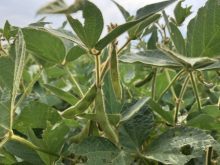At one point last summer Joe Hofer’s durum crop looked yellow and unhealthy.
“The crop was sick and I was sicker,” said the farm boss for the Spring Creek Hutterite Colony near Maple Creek, Sask.
But by year’s end he had a crop worthy of first place at the Canadian Wheat Board’s 2002 Master Durum Grower competition.
The key to the turn-around, said Hofer, was a second application of nitrogen after a heavy mid-June rain.
“By golly, I think we made ourselves about 10 bushels with that 20 pounds of N we put on. The protein went up too.”
Read Also

No special crop fireworks expected
farmers should not expect fireworks in the special crops market due to ample supplies.
In the fall, the 4,000 acres of AC Avonlea durum the colony planted averaged 50 bu. per acre and had a protein content of 15 percent.
“It was the money maker,” said Hofer. “We grew Kyle too and Navigator, but this was the better stuff. It’s got more protein most of the time and that’s what we’re getting paid for.”
He managed to get a number two grade out of the Kyle durum by blending it with some of the top quality Avonlea, but the Navigator could muster only number three due to sprouting problems.
Hofer’s prize is an all expenses paid weekend for two in Toronto, a trip that was well-earned, according to CWB vice-president Earl Geddes.
“In a year where farmers had to face all kinds of challenges, it takes a great deal of determination and hard work to produce durum of this quality.”
The Spring Creek Colony’s award-winning crop of Avonlea was direct seeded into stubble on April 8. The seed was treated with Dividend XL, a fungicide product from Syngenta.
“When you seed early you’ve got to have that on there,” said Hofer.
In addition to the 20 lb. per acre of liquid nitrogen applied in June, the farmer used a drill to apply 20 lb. of nitrogen and 15 lb. of phosphorus in the spring.
For grass and broadleaf control he used Harmony Total, a product from Dupont Canada that Hofer said was easy on the crop and got rid of wild oats and other problem weeds.
At harvest, the colony straight cut its durum, which had a 17 percent moisture content. The crop came off early and was placed in aerated bins to preserve its amber colour.
But Hofer said the reason the Spring Creek Colony’s durum beat out 75 other samples has more to do with good weather than good agronomic practices. He estimated the farm received more than 50 centimetres of rain in 2002.
“After two years of drought, we needed this. We didn’t have too much of a crop last year with all the drought down here.”
He also credits developers of the durum variety for the farm’s success in the competition.
“It’s a winner, that Avonlea, for me.”
Hofer plans to grow another 8,000 acres of durum in 2003 but will increase the proportion of Avonlea from half to three-quarters of what goes in the ground. Navigator will be dropped from the lineup.
Hofer said he didn’t plan on entering the contest until he saw a Master Durum Grower sample bag at his local elevator. He filled it with durum from one of the colony’s better bins and ran the sample through a shaker at the elevator to take out the chaff.
Hofer insists he submitted bin-run seed and did not pick out unwanted kernels by hand.
“It looked darn good to me but I never figured on winning.”
He and his wife will take the free trip to Toronto some time in February or March, where they plan to enjoy sights like Niagara Falls and unwind after another tough year of farming.
“A farm boss needs a little bit of stress relief,” he said with a chuckle.















